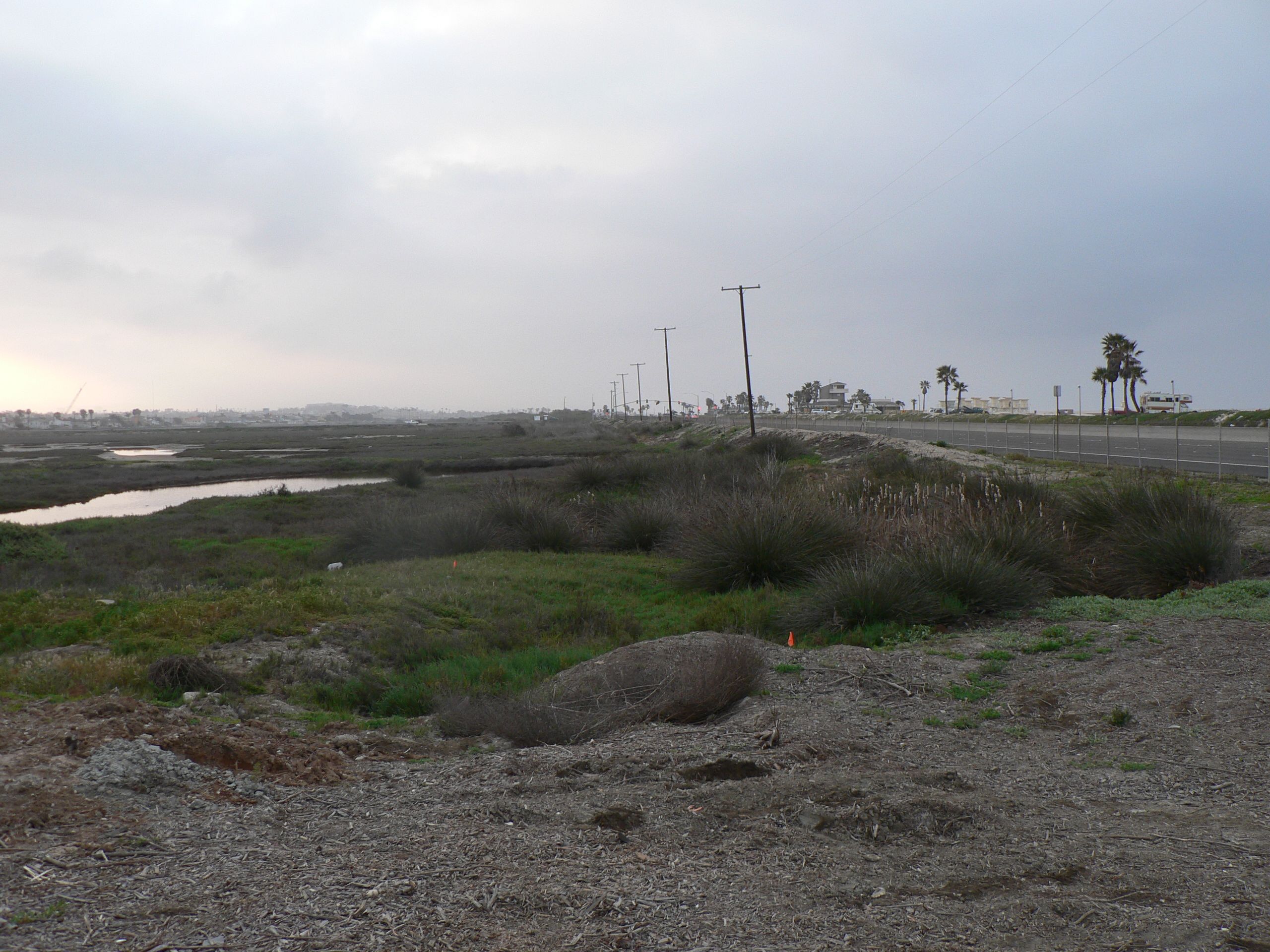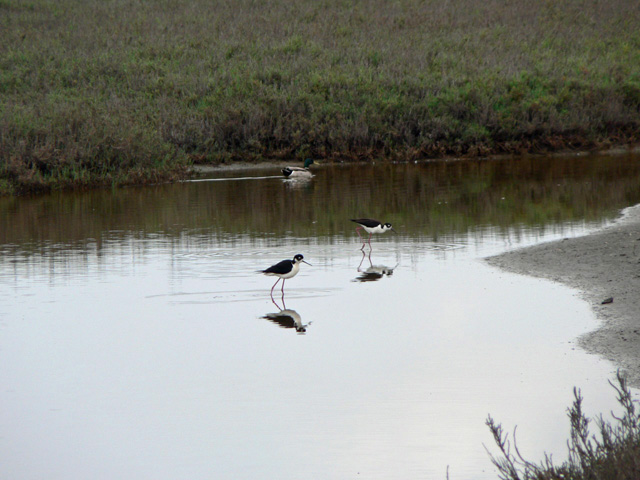#405 and 406 in Huntington Beach Wetlands
Before I get on the plane to China I thought I’d try to catch up on recent birding events, since hopefully even with Beijing’s notoriously poor birding and my inability to recruit a local guide, I’ll pick up quite a few species I’ve not seen elsewhere.
Saturday, April 5, I woke up at 5:00 A.M. to get out to Huntington Beach at 6:00. The occasion was the quarterly bird census at the Huntington Beach Wetlands Center. This is about 100 acres of mostly salt panne habitat along Pacific Coast 1, mixed in with industrial plants, housing, and roads. Somehow several large and small parcels have been saved from the sprawling development of Huntington Beach, and the hope is to save more. Restoration projects are scheduled planned to improve the habitat, so we’re counting the birds to track the effects of this eventual work. Plans are to dig a channel to flood some of the areas starting this September. Censuses have been ongoing for about a year and a half now to establish a baseline to measure the success against.
My team of four people (me + Tom Dixon, Pat Cabe, and Dick Cabe) covered the first three parts of Magnolia Marsh. This is a contiguous rectangle divided by habitat into zones 1, 2, and 3. Zone 1 is a narrow riparian strip along Pacific Coast 1. Zone 2 is mostly salt panne in the middle of the plot, and zone 3 turns from the centerline of the levee, southwest to the border of the salt panne. A small canal borders Zone 3 parallel to Pacific Coast 1, but was not included in our territory. Other teams covered zones 4 through 19, including several areas not usually open to the public.

We more or less circumnavigated the rectangular area we’d been assigned, starting from the corner near the wildlife refuge and moving counterclockwise. Initially we picked up all the usual suspects: Song Sparrow, Common Yellowthroat, Mourning Dove, and European Starling. Equally numerous were Belding’s Savannah Sparrows. This usually rare subspecies is holding on only here, at Bolsa Chica, and at a few other similar isolated habitats along Pacific Coast 1. It’s less yellow, and has much darker, denser breast streaking than the Savannah Sparrows I’m used to from Floyd Bennett Field and Fort Tilden back home in New York.

Scoping the salt panne in area 2 we almost immediately found hundreds of shorebirds. Western Sandpipers were the most numerous, but we also tallied many Least Sandpipers, Willets, and Dunlin. No Dowitchers or Curlews though.
We had the usual flyover species: Ring-billed Gull, Western Gull, American Crow, Common Raven, and several herons including Great Blue Heron, Snowy Egret, and Great Egret. However the best was a bird I initially miscalled as a Ring-billed Gull, because, well, it didn’t seem to fit anything else I knew; and Ring-billed Gulls are pretty common out there. Fortunately Pat and Dick were more familiar with the local avifauna than I was and correctly noted that the almost complete lack of black on the wings tagged it as a Glaucous-winged Gull, life bird 405 for me.
After that we turned North along the east edge and Magnolia Road. We continued upping the tallies of Song Sparrow, Savannah Sparrow, and Common Yellowthroat. We added our first Black-necked Stilts in a small inlet. I also got my first taste of the local pickleweed, a common edible plant of the salt marsh that tastes like a slightly dill, slightly sour, very salty pickle.

At the north edge, we split up into two groups of two and walked separate paths back west. The Cabes stayed down in the salt panne while Tim and I hiked back along the levee. This gave us excellent views of the canal, which added a few species for us including Eared Grebe. However the canal wasn’t in our official territory so we couldn’t count them. We had high hopes for two Barn Swallows that kept hawking for insects, then perching. However they never crossed into our official count area.
By the time we reached the Northwest corner, the salt panne was alive with hundreds of Semipalmated Plovers. We must have missed them fly in because I’m pretty confident they weren’t there earlier when we’d been scoping the same area from the other side. Somehow out of all these, Dick found one single Western Snowy Plover. It was fairly obvious in my scope once I was told where to look, and that was life bird #406 for me.
We closed off the rectangle heading south toward the ocean, but this didn’t really add any more to the taly since we were now recovering a lot of the same ground from a different direction. We finished the day with 26 species and maybe a thousand or so individuals:
- Mallard
- Double-crested Cormorant
- Great Blue Heron
- Great Egret
- Snowy Egret
- Snowy Plover
- Semipalmated Plover
- Killdeer
- Black-necked Stilt
- American Avocet
- Willet
- Western Sandpiper
- Least Sandpiper
- Dunlin
- Ring-billed Gull
- Glaucous-winged Gull
- Rock Pigeon
- Mourning Dove
- Anna’s Hummingbird
- American Crow
- Common Raven
- Barn Swallow
- European Starling
- Common Yellowthroat
- Savannah Sparrow (Belding’s)
- Song Sparrow
- White-crowned Sparrow
Not bad for a couple of hours.
After the official count was over, I drove across the highway to the beach to try for the Glaucous-winged Gull again, since I wasn’t so happy with my initial misID. I didn’t find it there, but I will keep an eye out for white-winged gulls around here in the future; and I’m looking forward to the next quarterly count in July.
